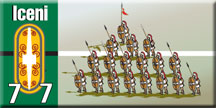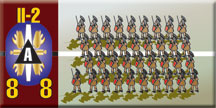| Queen of the Celts
Scenario Preview
Queen of the Celts is a scenario-rich environment, covering both the resistance to Roman invasion and Boudicca's "rebellion" a generation later. Plus some ore fighting on top of that. Here's a look at what you get in the package:
The Medway
Summer, 43
Plautius was able to land unopposed in Kent,
in three beachheads based around the Wantsum
Channel. The Romans quickly and efficiently
organized themselves for the coming campaign.
Caractus did not even have the option of opposing
this, as he had to again rally the scattered
tribes for warriors. This proved more difficult
than before, as with the Romans actually ashore,
there were Britons who believed the chance
to resist them was over, and having prospered
via economic ties to Rome, were lukewarm about
fighting. He could only assemble as many warriors
as possible a safe distance away from the
Romans and await their first moves.
Plautius moved out of his secure bridgehead
with the invasion already planned in successive
stages. The first stage was to cement the
conquest of southeastern Britain and to do
this he would expand and improve on Caesar’s
second campaign. At the River Medway he would
meet Caractus. The latter had destroyed the
bridges and slightly outnumbered the Romans
so he felt pretty sure about his positions.
The resourceful Romans, using agents among
the disaffected, knew something about the
lay of the land. On their left flank, out
of sight of Caractus, the II Legion forded
the river. On the right the Batavian auxiliaries
and supporting troops did the same.
The Batavians joined battle first, and Caractus
sent his mobile formations, chariots and light
cavalry to deal with them. Then the II Legion
arrived and he had to dispatch a larger infantry
force against them. As the battle raged on
both flanks north of the river, Plautius began
to cross the Medway with the XIV Legion against
lighter opposition than Caractus would have
offered otherwise. Fighting was fierce and
the Celts gave as good as they got but when
the XX Legion arrived on the flank to reinforce
the II, it became obvious to Caractus that
the battle was lost and he retreated in good
order to the north.
 
The Thames
Summer, 43
Plautius paused long enough to gather his
forces together north of the river and prepare
the next stage of his advance, as more reinforcements
from the beachhead arrived. Caractus withdrew
north of the river Thames to do the same.
Once again he sought to use the river as a
shield against the Romans as he gathered more
support. After the retreat from the Medway
this became even more difficult as many tribal
elders saw the futility of opposing the Romans
and wanted to salvage as much independence
as possible by cooperating with the invaders.
Caractus’ force north of the Thames
was a shadow of the army fielded at the Medway.
Some warriors melted away, and most of his
mobile forces had been lost covering the retreat
from the earlier battle. The Roman navy, which
would prove a wonderful resource to Plautius,
helped in the crossing of the Thames outside
of Caractus' reach. The XX and II Legions
and support fell upon the Britons, who took
up position in the marshy fens since they
lacked chariots and cavalry to fight over
more open ground. Fighting was fierce and
casualties heavy to both sides but Caractus
was forced to withdraw as morale collapsed
after the death of his brother, the brave
Togodumnus.
The Fall of Camulodunum
Fall, 43
Politics now entered military operations
for the Romans. Pausing north of the Thames,
Plautius sent word to Rome that the campaign
was no longer in doubt. Claudius hit the road
with a vengeance, and reinforcements were
already gathering on the Gallic coast. Once
Claudius arrived, and records seem to indicate
he stayed less than three weeks in Britain,
the Romans struck out towards Camulodunum
(modern Colchester), one of the most prosperous
and frequented seaports in north-east Europe.
Its fall would demonstrate Roman might and
the futility of resistance.
Employing the IX and XIV Legions which had
largely escaped damage in the earlier battles,
the Romans advanced with Claudius “commanding.”
Contemporary accounts are at odds but it appears
the Imperial procession was opposed near the
river Lea by local forces that had rallied.
Seeing the elephants which Claudius brought
across the channel, the Celtic war ponies
had a collective coronary and the opposition
was brushed aside quite easily.
Rape of Maiden Castle
Spring, 45
The future emperor Vespasian took his II
Legion and supporting troops into south-western
Britain with multiple purposes in mind. The
subjugation of local tribes was of course
a good thing. He also needed to establish
a land route for supply purposes to aid Roman
expansion in the north. Sea travel around
Land’s End between the English and Bristol
Channels was treacherous due to tides and
winds. A secure land route was highly desirable.
Resistance was scattered and largely ineffectual,
as Vespasian would take one Celtic hill fort
after another, defeating the tribes piecemeal
as with Caractus far to the north, no one
was able to unite them.
The most fierce opposition to Vespasian
came at a large hill fort known as Maiden
Castle. With intricate wooden and earthen
ramparts and walls, the defenders stoutly
resisted the Roman attack. Fighting was fierce
and casualties heavy. Archeological evidence
is not clear whether the Romans actually occupied
the fort after the fighting. There is some
indication that, having broken the back of
the local tribes who made their stand there,
Vespasian moved on without occupying the castle,
as his aim of destroying the armed warriors
was more important than detaching a garrison
at every turn.
Hit and Run
Summer, 47
The Romans spread north and west in gradual
stages. Advancing with both cohorts and diplomats,
one tribe after another would subjugate voluntarily
or otherwise. Most saw the economic advantages
of this and conquest proceeded largely without
trouble. Plautius would leave the island in
46, being replaced by Marcus Scapula. Caractus
and the opposition were hardly inactive during
this time. He would lead a guerrilla war against
the occupation forces and traitors that would
gain him a great reputation across unoccupied
Europe and the Roman Empire itself.
This scenario is typical of the raids lead
by Caractus against the occupation forces.
Supply and relief columns could be hit and
destroyed, making life miserable for the Romans.
Sadly, such tactics could not turn the tide
of the campaign.
Last Stand at Caersws
Summer, 51
The Romans slowly spread like a disease
throughout the island. The followers of Caractus
dwindled though the great leader did not give
up the fight. His strategic maneuvering caused
Scapula to split off the XX Legion among the
Silures while Scapula continued his Welsh
campaign with the XIV. Seeing a chance at
defeating the Roman general, Caractus offered
battle at the hill fort at Caersws.
Caractus misjudged the Romans in a set piece
engagement once more. Using the testudo formation,
the Romans were largely immune to Celtic sling
stones. The fighting was fierce but Rome clearly
carried the day and Caractus escaped and attempted
to rally support among the mighty Brigantes
tribe, whose royal family was divided in loyalties.
Their ruler, Queen Cartimandua, seized him
and handed him over to the Romans, and our
brave but luckless hero would later occupy
the place of “honor” in a Roman
processional triumph. The Queen’s husband,
Venutius, not impressed with his wife's perfidy,
would divorce her and raise the banner of
resistance for years to come in the northern
parts of the island.
A Woman Scorned
Summer, 60
By the summer of 60, the entirety of what
is considered England proper was under Roman
rule. Scotland was still not subjugated and
Wales was still restive. It was in the latter
that the current governor, Gaius Paulinus,
was campaigning in an effort to destroy the
Celtic Druids in their stronghold. The Iceni
were one of the many tribes who had submitted
to the Romans and had prospered somewhat by
that association. When the Iceni king died
the Roman administration saw an opportunity
to put an end to the charade of self-rule
and took over the tribal lands. When the wife
of the late king strongly protested she was
beaten and her daughters raped. Boudicca escaped
to foment rebellion that had been smoldering
underneath the surface of Roman rule. Warriors
flocked to her banner and Roman cities were
sacked and their inhabitants (both Roman and
collaborators) were put to the sword. One
by one the cities fell and Paulinus hastily
rushed back to meet the last great threat
to Roman hegemony.
With the XIV and XX Legions fresh from their
victorious pacification of Wales, Gaius Paulinus
knew he would be outnumbered badly by the
revolting tribes. On a hill near present Lichfield,
he made his stand. The Britons did indeed
outnumber the Romans, but many were non-combatants.
The Britons attacked frontally, as the terrain
permitted little else. The war chariots led
the attack, which was a tactical mistake by
Boudicca. Not able to maneuver with a mass
of infantry charging behind, they were quickly
destroyed. Once the lines were joined the
Romans actually began to advance. In the cramped
melee the tribal numbers could not be brought
to bear and the warriors had little room to
swing their broadswords. This was the legions’
style of warfare at its best. Morale broke
and the warriors began to scatter. The camp
followers and baggage carried by the host
delayed getting back across the Anker river
and the slaughter began in earnest.
Search and Destroy
Winter, 73
By this time resistance had all but collapsed
everywhere but in the north. Venutius would
lead a brilliant but ultimately futile irregular
war against the Romans. While he would have
successes he could do little to disturb the
pacification of the island. Attacking isolated
garrisons and ambushing foraging parties were
the limits of his reach as the Romans slowly
pushed further north.
The Romans were constructing a fort near
modern York when attacked by Venutius' men.
They were being slaughtered to a man before
the garrison’s cohorts could move against
the rebels. In the end it mattered little.
The Romans returned to build and with the
garrison on alert the string of settlements
and fortifications would grow one by one.
Celtic Twilight
Summer, 84
Rome would push further and further north,
and organized resistance became more futile,
an exercise in both bravery and foolishness.
The newest governor, the most able Julius
Agricola, took the field with two legions
well supported by auxiliaries into Scotland.
Opposing him was the last Celtic force under
arms that could be called an army. Under the
chieftain Calgacus nearly 30,000 warriors
would make a last stand before the highlands.
The battle was almost a foregone conclusion.
Perhaps it could have been better fought had
the Celts remained on their hill in a defensive
position. But as the Romans advanced the Celts
came off the hill and attacked, routing some
advanced auxiliaries before the legions could
intervene. They were then attacked on both
flanks by light forces and assaulted by the
legions in the center. As dusk fell the Roman
was master; though as both Hadrian's and the
Antonine Wall suggest, the entirety of the
island never fell beneath Roman sandals.
Put some Celts on your table! Order Queen of the Celts today! |
